- Best Smoker Grill Combo Guide: Top 5 Recommendations - September 1, 2021
- Best Ground Coriander Uses: The Ultimate Seasoning Guide - August 3, 2021
Let’s talk about salami. It’s one of the most popular types of sausage in the world! But what exactly is it?
This type of sausage was originally created in Italy, but it’s just so delicious, that it’s since spread all over the world. Salami can be cut into slices like ham to serve in a sandwich, or for use on pizza toppings, cut into chunks to add to pasta, or sliced into slivers to place on a charcuterie board. The meat comes in many shapes and sizes – some salamis are spicy while others are very mild with extra flavors like garlic or cheese. Salami types also vary by region, which is why we’ve explored many types of salami from all around the world.
Packed with protein and flavor, salami can make many different meals better! Read on to find out more about this delicious meaty foodstuff, some of the most popular types of salami, and to discover the answer to all of your salami-related questions.
What is Salami?
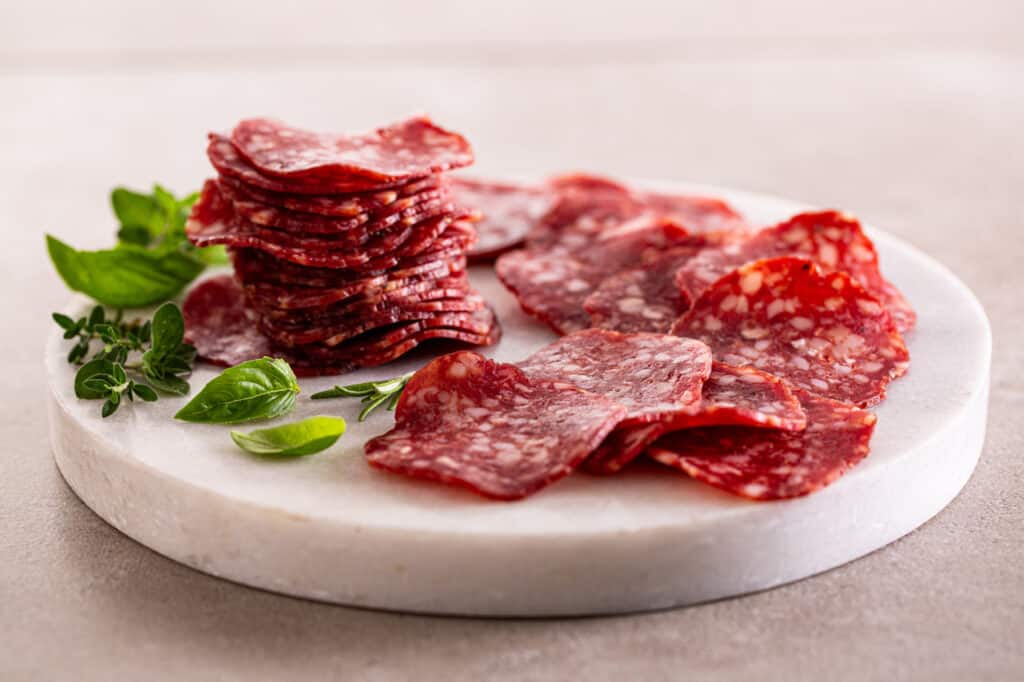
Salami is a processed meat that has been cured with salt and then flavored with sugar, spices, and other seasonings. It can be used for a variety of dishes, or ate on its and originated in Italian culture.
Where Did Salami Originate?
The types of salami we know today originated in Italy. It was originally developed as a way to preserve meat before the invention of refrigeration. In fact, Italian families would make it in batches and bury it underground during the winter months when they couldn’t hunt or forage food sources to feed their family members.
These days, there are many types of salami and what type you purchase will depend upon your taste preferences and where you live.
The History of Salami
The discovery of salt is what made salami as we know it today. The Ancient Romans had a dish called ‘salsum’, which means “salted” and the first records of this type of food dates back to the prehistoric time period.
Even in these ancient times, people were already aware of how essential salt was for preserving meat. It expels water and blocks bacteria from growing, meaning it was a perfect ingredient for preserving snacks. However, over the centuries there have been many modifications in ingredients used to make salami, such as spices and seasonings. but one thing has remained constant—the use of salt as a curing agent!
Salami belongs to the category of air-cured meats called salumi insaccati (“incased”). This is because the meat is wrapped in a natural casing made from pig intestines. Salami is typically made with pork, though in rarer varieties, salami may be concocted from wild boar, beef, veal, or even duck. The meat is ground and kneaded to achieve the desired flavor, and then various spices are added according to a specific recipe.
When preparing salami, there are certain cuts of pork the butcher uses. The most common is the thigh and shoulder – both being leaner types of meat with little fat. Additional cuts used include loin, filet, and the belly which are all fattier. Additionally, sometimes the jowls can be added to give it a succulent texture. Salami then tends to be aged between 30 and 90 days.
A good salami has to have the right balance of lean meat and fat. The tendency today, especially for industrial products, is to make less fatty ones which affect the taste and texture. But artisanal products are made without any artificial additives or substances that might compromise their quality–“fatti come una volta” as they say in Italian means “made as they used to be”, and that is exactly what a good salami should be.
The Different Types of Traditional Salami
There are many types of salami, and which you prefer will vary depending on your personal preferences. Some types include:
Genoa Salami
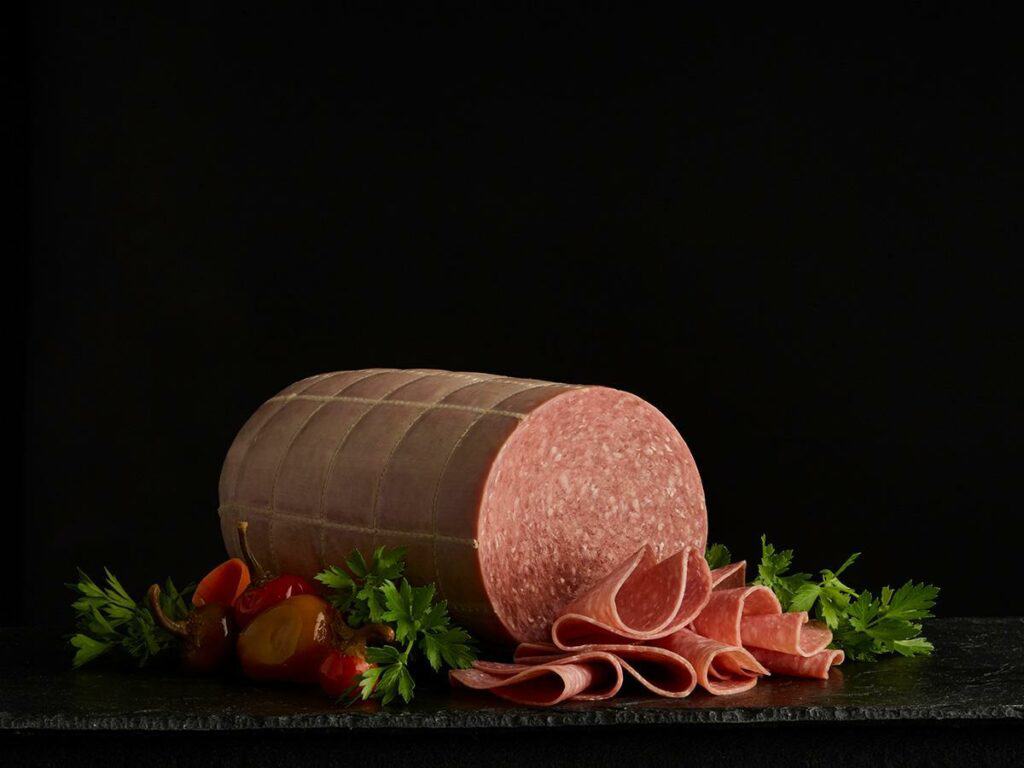
This type of salami is made from pork, sea salt, sugar, spices, and garlic. It’s often dry-cured before it’s thinly sliced or chopped into pieces that are then ready to eat. As the name suggests, it comes from the Genoa region of Italy and goes with a range of everyday recipes and charcuterie boards.
Cotto Salami
Cotto salami is a type of softer salami sausage that also originated in Italy. It’s made with ground pork, salt, cinnamon, pepper, nutmeg, milk, mace, and peppercorns. This type of salami is air-dried and is usually sliced into thin strips depending on how it will be eaten. Its soft texture makes it more perishable than Genoa salami, so it will not likely keep as long.
Felino Salami
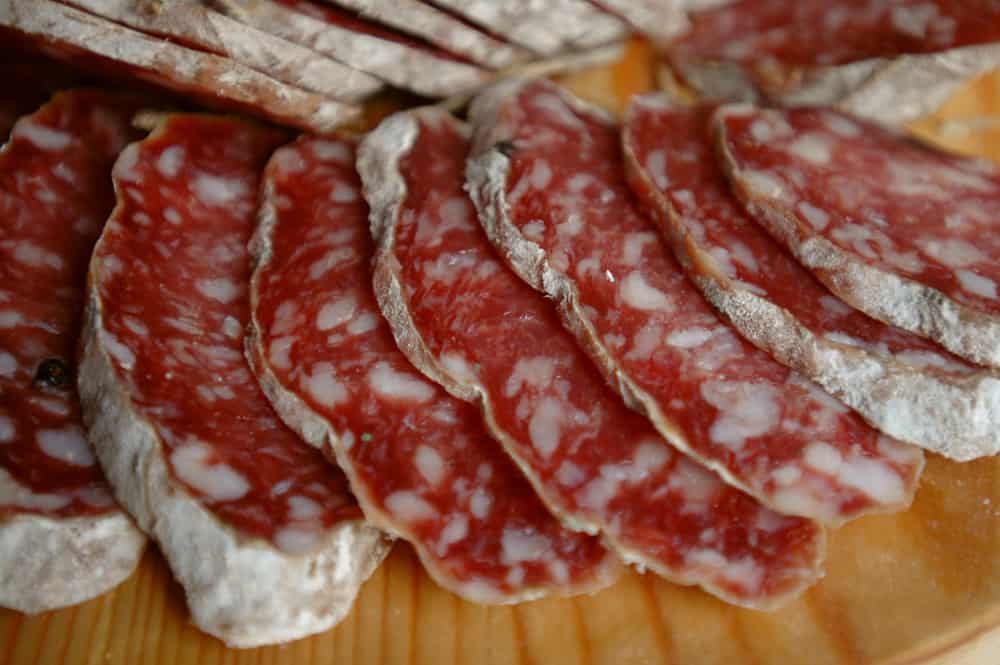
Felino salami is named after the Italian town from which it originates – Felino. Also known as “the king of salami”, it’s made with pork, salt, cane sugar, spices, Chianti red wine, and garlic. This type of salami is known for its smooth texture, dazzling flavor, and rich taste. It contains very generous portions of crushed black pepper and wine yet has a minimally spiced taste. The slow aging process takes the sweetness to an intense level and the appearance is bright red when you cut into it.
Hard Salami
This type of salami can be made from both pork and beef and is usually flavored with salt and spices. As you might imagine, it’s quite a hard, firm sausage. It’s also quite moist which makes it more difficult to chew. This type of salami doesn’t require any fermentation process so it can be eaten right after processing but the flavor will diminish as time goes on without proper storage.
Mortadella
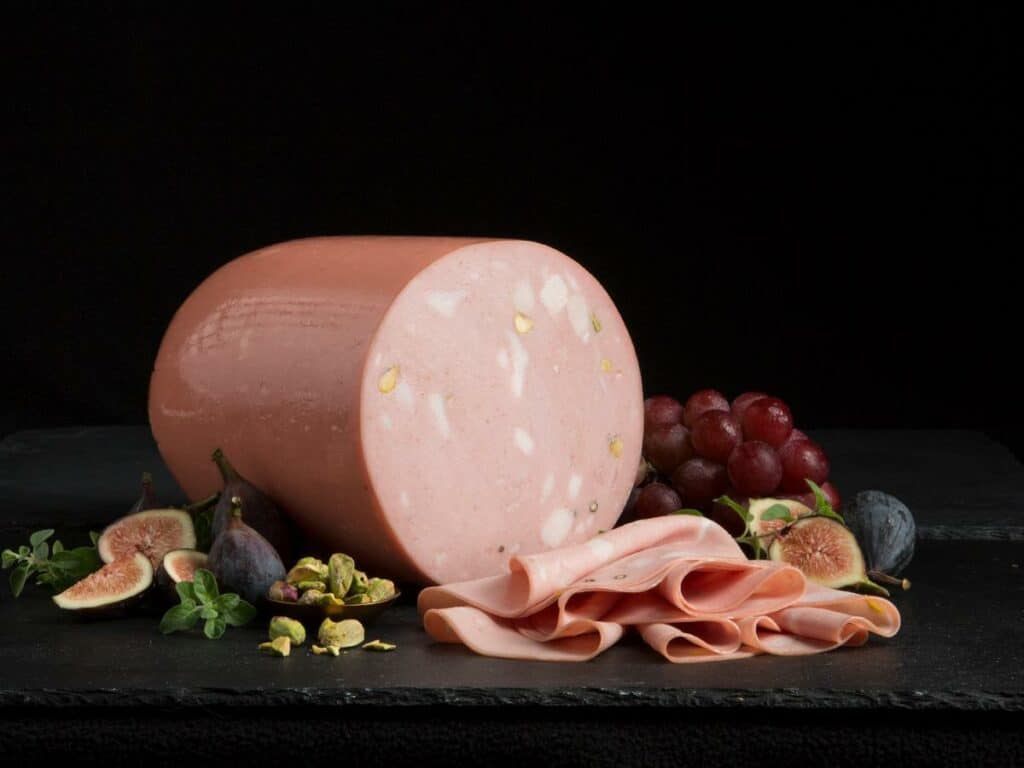
Mortadella’s origins can be traced to the north-central Italian city of Bologna. This type of pale pink salami is made from pork, salt, and spices and is traditionally air-dried for a few weeks before being cut into slices. It tastes almost hammy and is often studded with peppercorns or spices like coriander. It can be eaten on its own or used as an ingredient in other recipes like bolognese sauce.
Finocchiona
Finocchiona is made with a mixture of spices and fennel seeds. It’s originally from the Tuscan region of Italy and how it came to be flavored with fennel remains a bit of a debate. One story goes that a man stole some fresh salami from a market stall in the town of Prato in Tuscany and hid it in a fennel field.
When he came back to get it a few days later, it has absorbed the fennel flavor and hence the Finocciona salami was formed. Another story suggests that pepper (which is usually used to flavor salami) was too expensive for a Tuscan local, so he substituted fennel instead when making his salami and the flavor became popular with others.
‘Nduja
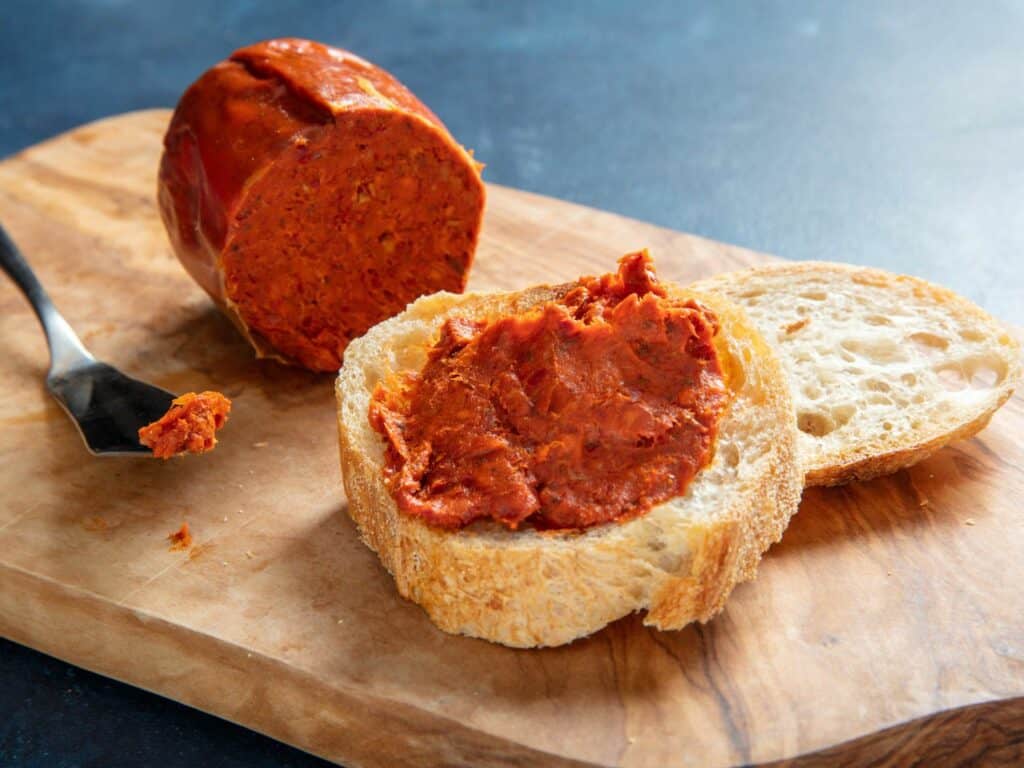
‘Nduja is a spicy sausage that originated in Italy’s southern region of Calabria. Pronounced “en-DOO-ya”, this salami is versatile and bold. It’s salty and peppery, with hints of garlic and lemon–the aroma is quite incredible. The type of meat used to make this type of salami is usually pork, but normally a finer cut of the animal is taken from the shoulder, belly, jowls, or even offal. It traditionally accompanies antipasto dishes such as olives and roasted peppers, but it is also delicious on top of pizzas.
Sopressata
Sopressata is made from coarsely chopped pork. It’s a very firm and dry-cured sausage which contains salt, black pepper, ground cinnamon, or nutmeg. It is usually mild, although can come in an intense, spicy flavor (created by substituting black pepper for crushed Calabrian red pepper flakes) which may take you by surprise if you’ve never tried it before. It has a smooth and bold flavor, which makes it perfect for appetizers.
Pepperoni

One of the most popular types of salami on this list, pepperoni actually grew in popularity through Italian-American butcher shops in the early 1900s, as opposed to in Italy itself. These days, it’s found in most grocery stores around the US and is also the US’s favorite pizza topping. Made with pork, salt, and spices such as black pepper or chili peppers for flavoring, this sausage is also usually smoked which gives it that signature smoky flavor.
Salsiccia
Like a few other types of salami on this list, salsiccia is made from coarsely chopped pork. The difference with this type of sausage-style salami is that it typically contains pancetta scraps and pork neck bits seasoned with garlic, thyme, white wine, cinnamon, and pepper. It can also be dry-cured to some extent if desired. Some variations of the flavor also include caciocavallo cheese, fresh chili, sundried tomatoes, or fennel.
Prosciutto
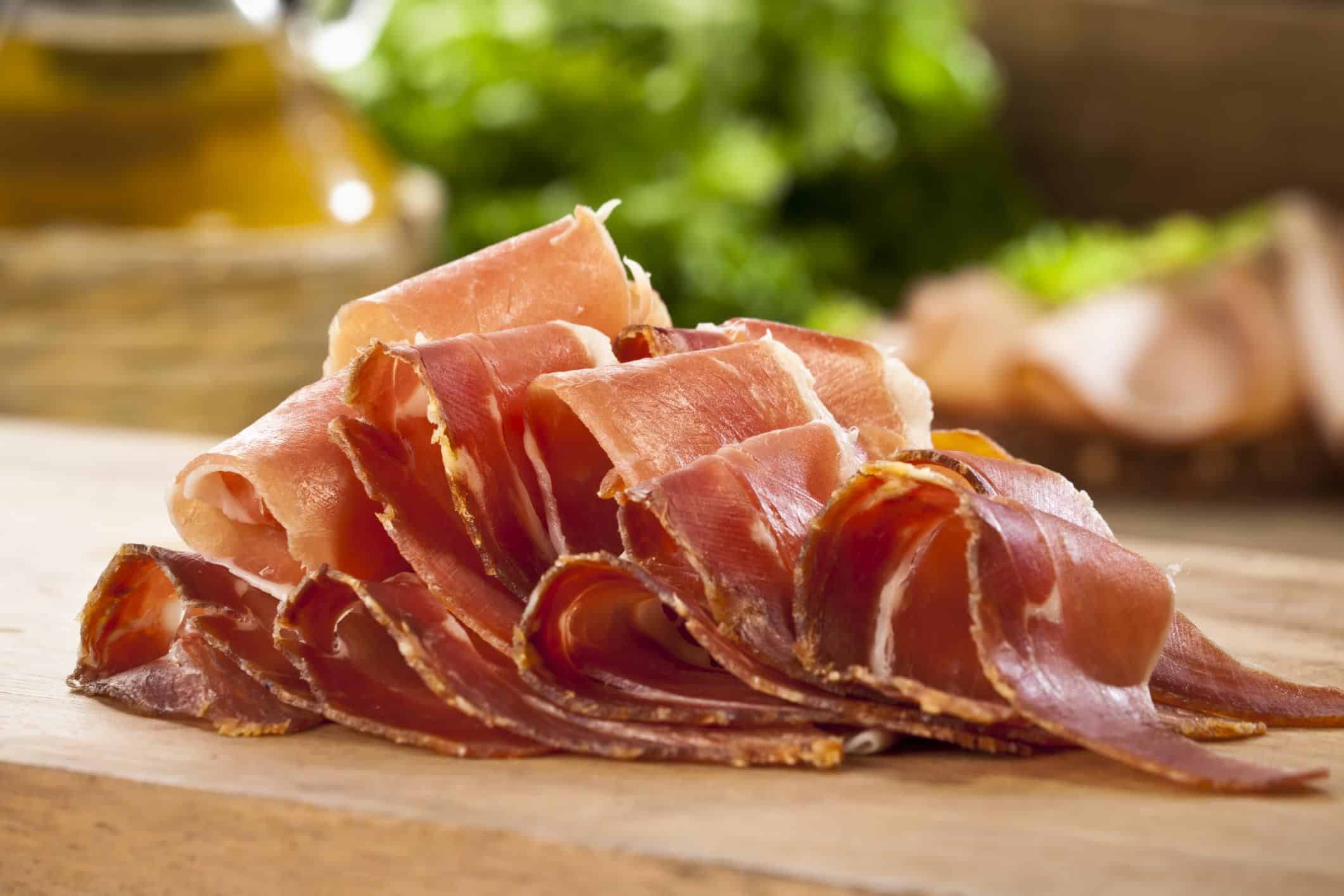
A type of dry-cured ham, prosciutto is made from a pork leg or shoulder that has been seasoned and then sliced wafer-thin. There are various types of prosciutto including prosciutto cotto which is often generously seasoned before it’s roasted, boiled, or smoked, leaving it similar to American, or deli-style, hams.
The term “Proscuitto” can also refer to other lower-leg meats like culatello, which is a specialty of Parma made from the boneless muscle mass in the rear leg of the pig. This is prized for its richer taste and tender texture. However, all Proscuitto is ‘raw’ and cured for a year or longer.
Chorizo
A spicy sausage, chorizo is made from pork and seasoned with smoked paprika, garlic, cumin, black pepper, or other types of spices. It can also have red wine as an ingredient which makes it a little moister than most types of salami on this list. Originally from Spain but now eaten all over the world, chorizo is usually eaten as an appetizer with bread or in dishes like paella.
There are typically two types of chorizo – Mexican and Spanish. Mexican chorizo is made from red chilies, garlic, and oregano, and ground pork, usually sold fresh and uncooked.
In comparison, Spanish types – although they also contain ground pork and mixed spices – undergo a curing process, leaving the salami harder, dryer, and technically, the only one of the two that can be classed as a type of salami. These days, you can also get several types of chorizo including one with extra spice and a low-fat version.
Speck
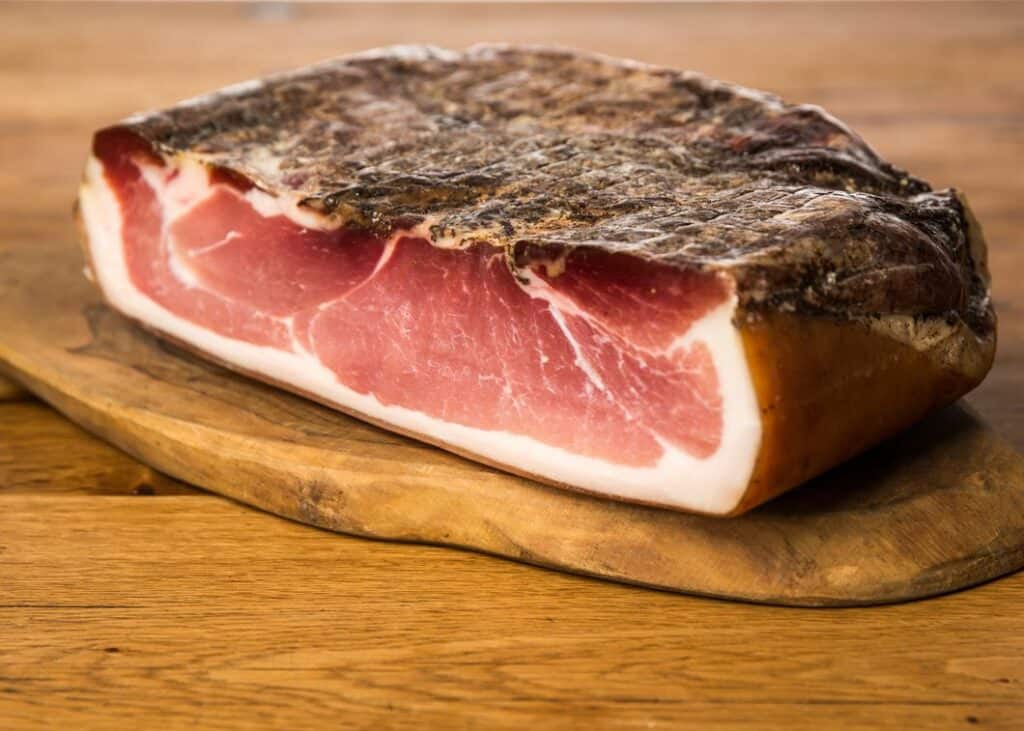
Another dry-cured ham, speck is made from the loin of a pig. It’s usually smoked, salt-cured and seasoned with salt, pepper, juniper berries (or other types of spices), as well as sugar and rosemary. This type of salami has a salty, smokey yet sweet, and spiced flavor which makes it perfect on its own for appetizers like antipasti or on top of pizza. Speck can also be a great addition to a number of other dishes: sliced into pasta, layered with cheese on an omelet or quiche, mixed with greens and olive oil, or tossed into a warm vegetable salad.
Pancetta
Similar to bacon – and known as Italian bacon – pancetta is made from pork belly. It’s cured with a lot of salt for a few weeks and seasoned with pepper and spices before it’s sliced. It has a fatty texture which makes it perfect as an ingredient in various dishes but it can also be eaten on its own. The best types should contain an equal mixture of lean meat and fat. Pancetta is often regarded as culinary cured pork and used in Italian cooking such as different kinds of pasta or risottos, or mixed into sauces for a salty porky base for a range of dishes.
Peppered Salami
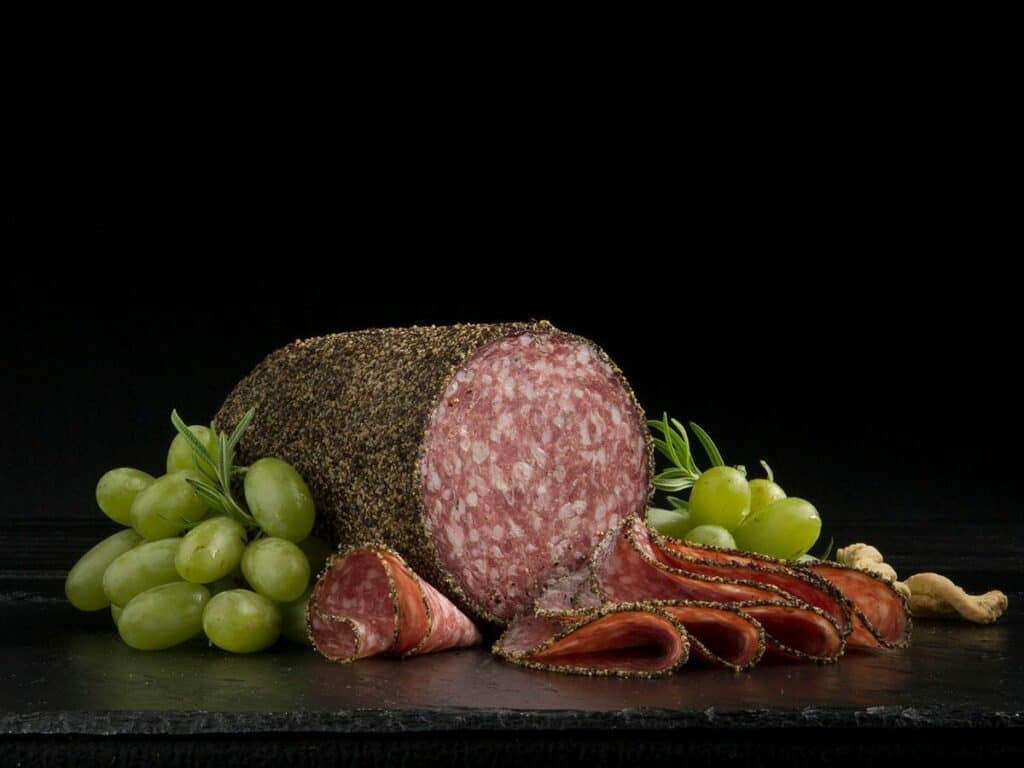
A type of finely ground salami that is dry-cured and then encased in pepper, this meaty sausage has a tangy, spicy flavor and some types are also smoked. With its spicy taste, it’s not the most popular type on this list but can be eaten in more ways than other types of salami. A few examples include grilling, eating in a baguette for lunch with salad, adding it to a toasted sandwich, or placing it on a charcuterie board.
Coppa
Also known as capicola in the US or capocollo in southern Italy, Coppa is a whole muscle pork cut that is cured or dry-aged for a month. After that, it’s seasoned differently depending on the region. In Parma, little more than salt is used, whereas, in Piacenza, they use nutmeg, cinnamon, and cloves. It can also be flavored with rosemary, garlic, black pepper, coriander seeds, fresh chili, wine, garlic, and many other ingredients.
Taken from the back of the neck and top shoulder of the pig, the taste can vary according to the type of meat used. The more fatty parts, like pork shoulder, make it softer in texture but also sweeter in flavor while leaner types are firmer, drier, and more savory. Coppa is typically eaten as a cold appetizer or on pasta like with Bolognese sauce, but you can also pack it into an omelet for breakfast.
Cacciatore Salami
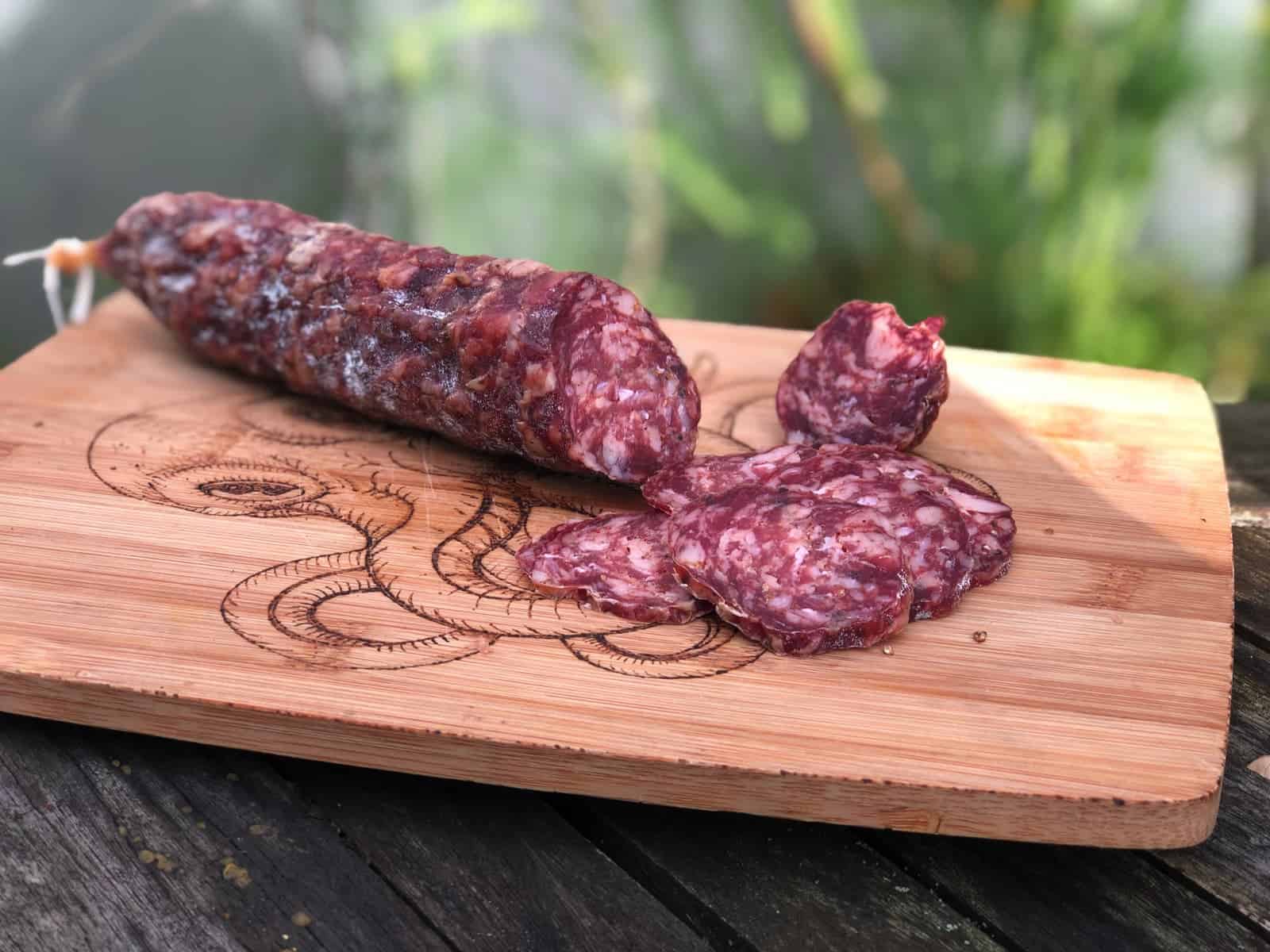
The types of salami on this list are all dry-cured, but some aren’t as heavily flavored or spiced. Cacciatore Salami falls into the category of semi-dried salami and is usually made with pork shoulder meat that’s been cured for around 18 months before being mixed with minimal spices: salt, black pepper, and garlic. This type of salami is then left for another two months before it’s ready to be eaten.
It has a very moist texture with an earthy smoky taste that makes it perfect in pasta dishes like cacciatore sauce or as part of a summer salad. The salty meatiness goes really well mixed with the crunchy vegetables and fruit. Cacciatore (nicknamed “hunter’s style” salami) is popular among hunters and outdoorsmen in Italy because it offers a tasty, substantial, and portable meal.
Guanciale
Made with pork jowl or cheek meat, guanciale (pronounced gwan-CHA-lay) has been cured with salt before it’s ready to be eaten. Pepper, bay, and juniper are usually also added to enhance the flavor. This tasty sausage usually packs a lot more fat than types like pancetta which gives the leaner cut some added flavor. However, as a result, it’s much better for cooking than eating raw and is a crucial element of popular sauces like carbonara.
Lardo
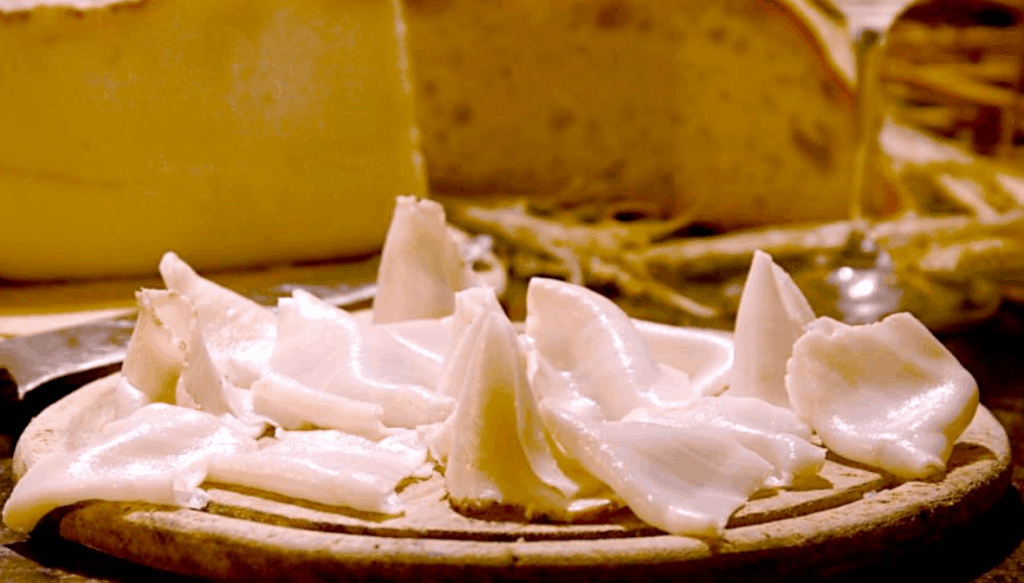
Lardo (which literally means “lard”) is soft, creamy, spiced, and cured pork fatback. This Italian delicacy has been made for centuries from pork back fat, salt, pepper, and spices like nutmeg or cinnamon before it goes into the curing process for around six months.
The authentic version is made with pork fat from Italy which has been dry-cured for around 60 days before it’s sliced thinly and served, often on top of the bread, as an appetizer. A buttery, tangy taste with an almost barbecued spice rub is characteristic of its flavor. When eaten by itself, this type of salami is usually served with a decent, hearty red wine.
Wine salami
This wine-cured type of salami is a little different than the types that have already been mentioned because it relies on alcohol to make it dry, not just salt. By using red wines like Chianti or Merlot as well as white wines such as Pinot Grigio and Sauvignon Blanc, this delicious sausage gets its characteristic sweet, fruity flavor. Typically this type of salami can be referred to as “wine-soaked” or “spicy wine”.
Bresaola
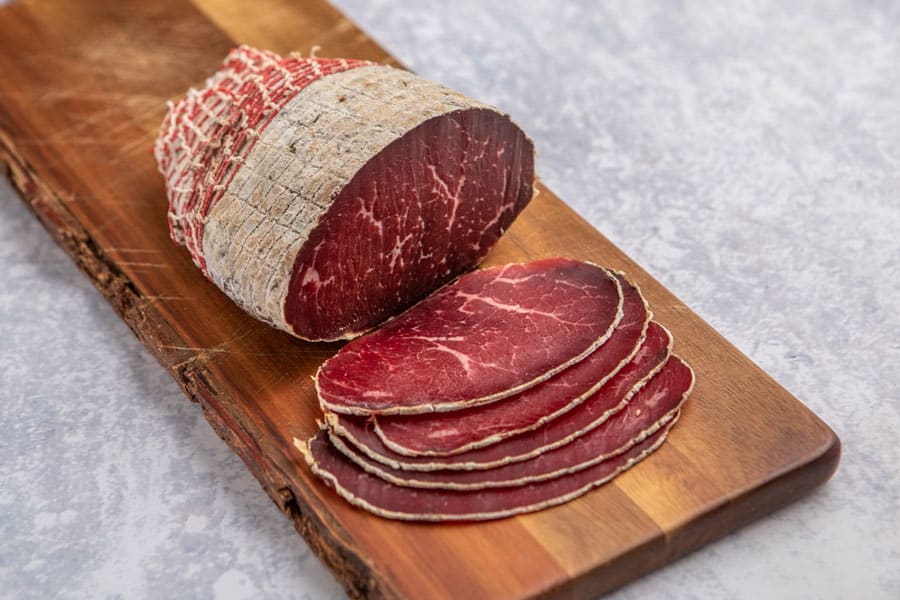
Bresaola is different from most of the other types of salami on this list because, where they are made from pork meat, bresaola is pure beef. It’s air-dried and then aged for at least six months before it can be eaten. It gets its name from the Italian word broccolo which means “sprout” because when this sausage goes through the drying process, types of mold called penicillium flourish on top. Bresaola can also be made with veal that’s been aged for around six months before it goes into the curing process.
It has a deep, earthy flavor – and is sometimes slightly smoked to aid maturing – and can be served sliced as part of an antipasto platter or mixed in pasta dishes like lasagna.
The Differences Between Salami and Sausage
Salami and sausages might sound like linguistically linked twins who share their DNA in equal parts – but they actually couldn’t be more different from each other. One key distinction between these types of meat products is how they get made: salamis use dry curing while sausages rely on wet methods to preserve them which results in an entirely different taste and texture. They are also used for very different things.
Salami is typically made by curing types of meat like pork, beef, or lamb with salt and spices. The types of salami on this list are all dry-cured, and many are heavily flavored or spiced. On the other hand, sausage is usually made by mixing types of ground meats (with anything ranging from 5% to 40% fat) along with other add-ins such as breadcrumbs, herbs, and vegetables before the sausagemeat goes into a casing.
As for the size difference: most sausages will have a specific diameter because they’re stuffed into casings. Then, when they are grilled, their exterior crisps up while still holding in all the juices inside. In comparison, salamis often come in long, thin types of shapes which can then be grilled or cooked in types of sauces or dishes. Frying salamis, chorizo, for example, will often release juices instead of keeping them locked in. This can give a delightful smokey flavor to the dish.
So, there are some basic differences between these types of products and it’s important to know what type you’re buying when shopping at the store.
What Are The Different Types Of Salami Around The World?
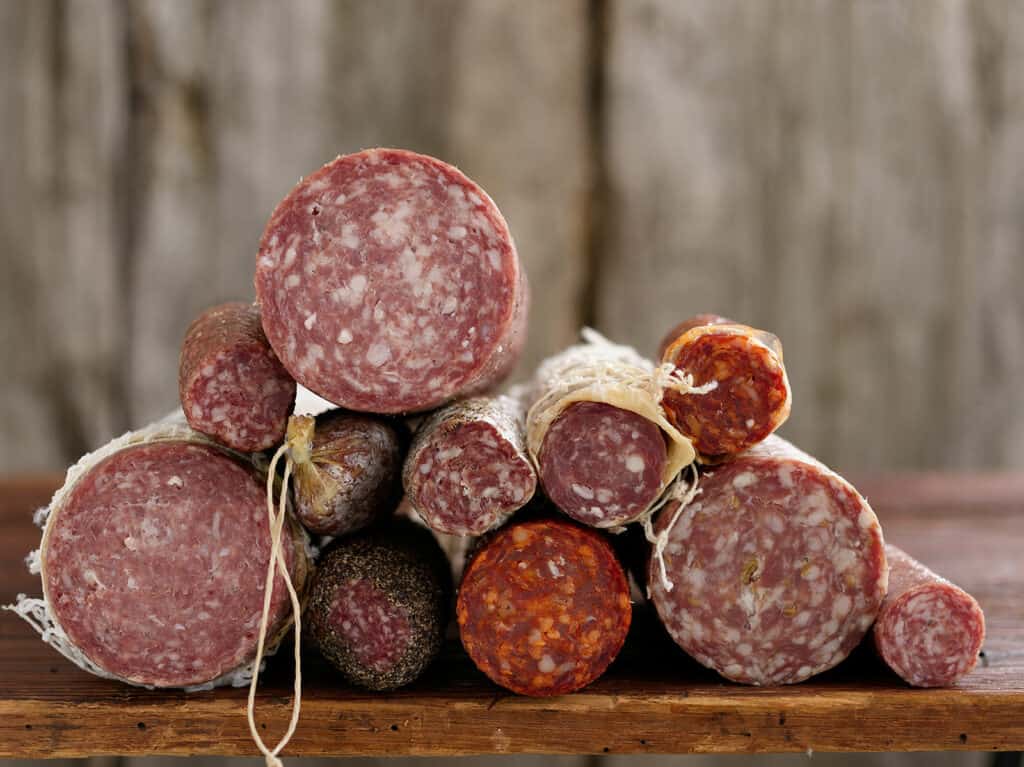
Although it originated in Italy, salami is no longer just from the Mediterranean country. Although most of them are Italian, there are types of salami on this list all come from different regions in the world. Here are a few more examples of types of salami around the world.
Westphalian salami is from Germany and is typically made with types of pork that have been heavily spiced before it has to be cured for around six months. German salami is typically much more heavily smoked than Italian salami.
Prosciutto di Parma is another type that comes from Italy, but also other places like Spain or Hungary. This type can only come from specific types of pigs raised in certain parts of the country.
Chorizo is typically from Spain but you can also find types of this salami in Portugal, Mexico, and other Latin American countries. It typically has a spicy or semi-spicy flavor to it because paprika is usually used for flavoring as well as the types of spices that are found throughout Spanish cuisine like oregano or cumin.
Sujuk is a type of salami that’s from the Middle East and Turkey. It is made with types of ground beef flavored with cumin, sumac, garlic, salt, pepper, red paprika, and (often) thyme. It’s found in a traditional Turkish breakfast.
As for the types of types you can find salami in the US, you have pepperoni – which is a dry-cured type that has been heavily spiced with black pepper and garlic powder.
There are many other types of salami that you can find across most of Europe and in the Middle East.
How to Cook With Salami

Many types of salami are typically eaten as part of an appetizer or a sandwich. However, some are much tastier as part of the main course.
Salami is really easy to cook with because it’s already fully cured so you only really need to grill it up until it’s crispy on the outside while still getting all those juices from inside onto your plate. That means that types like pepperoni wouldn’t require much more than taking them out of their packaging, putting them on a sheet pan with oil in between each slice (to prevent sticking), and then grilling them for about three minutes per side over medium-high heat before they’re ready to go.
For types like chorizo – which usually has a spicy and semi-spicy flavor to it – you’ll want to cook this type of salami a bit differently. But it’s still incredibly simple to do. Simply cut or slice it up and then fry or grill it up until that intoxicating spice mixture on the inside is released out into your frying pan.
If you’re not sure what type of dish would work best when using types of salami, here are types I’ve seen work best for types of salami:
- Prosciutto di Parma sandwiches with prosciutto, arugula, and a light balsamic vinaigrette on the side.
- Spanish chorizo tacos topped off with some fresh cilantro leaves and lime wedges (you can also add in types like peppers or onions if you want). You can also make a traditional Spanish paella with types of salami by frying the chorizo until it’s cooked through before adding things like shrimp, chicken, peppers, and rice.
- Pepperoni can be added on top of pizza, topped with cheese, and baked until the meat is crispy and the cheese is melted.
- Turkish sujuk wraps are made by slicing the sausage into thin pieces before adding it to an oven heated pita wrap along with types like cucumber slices, tomatoes, tahini sauce, hummus dip, and Sriracha hot sauce.
Top Salami Types FAQs
Question: What is the best type of salami?
Answer: There is no such thing as the “best type of salami.” Every type has its own benefit and types. Most types of salami have been around since antiquity so there aren’t many that stand out more than others in terms of popularity; it just depends on which region you’re from or like to visit what types you prefer. However, some of the most popular types include types like Genoa Salami, types of Spanish Chorizo (usually spicier and thicker), and types of pepperoni that you can find in the US.
Question: Is salami better than sausage?
Answer: This once again depends on what you want the meat for. Sausage types are typically made from pork and ground beef whereas salami types can be made with many different types of meats (depending on the region) and they come in a variety of shapes that range from slender to bulky. Salami will, however, typically keep longer than fresh sausages.
Question: What is the most important thing about curing meat?
Answer: The process for making any type of salami is curing it. This process removes as much moisture from the meat types, which helps to preserve it for a longer period. This can also help with making types like pepperoni less greasy.
The most important thing about curing meat has to do with ensuring that you’re using enough salt so that the types of bacteria that produce lactic acid don’t produce enough to cause spoilage.
Question: How long does it take for salami to cure?
Answer: Salamis is typically cured for 6–10 weeks, although types like pepperoni are made with types of beef that have more fat types in them so they can be cured for around three months or less.
Question: What is the most popular salami?
Answer: The types of salami that are most popular can depend on which region you live in or what types of flavor profiles people enjoy. However, there are types like Genoa Salami (which has been around since the 12th century) Prosciutto di Parma from Italy that have become more popular over time because they’re considered to be some of the best for their particular regions. Also, the ever-popular pepperoni can be found in many countries around the world.
Question: What does the word ‘salami’ mean?
Answer: The word “salame” means sausage made with pork whereas “salsiccia” means types of sausage made with beef.
Question: What is the difference between types of salami?
Answer: The main types are dry-cured and fresh sausages, but many types fall into different categories like semi-dry cured, types smoked or not smoked, or types with higher fat content.
Question: What is the best way to store salami?
Answer: Salamis are typically cured in salt so they need to be stored at temperatures between 36° – 40°. This can generally be done by storing them in your refrigerator, but you mustn’t be stacking other items on top and/or wrapping them because they will sweat as well as have too much moisture which can lead to spoilage. They should also not come into contact with sunlight; if this occurs then you’ll notice discoloration on the exterior due to oxidation. Most types of salami will keep for a few months when refrigerated.
Question: How many different types of salami are there?
Answer: There are literally hundreds of types of salami out there, so there really isn’t a way to answer this question. However, types like Genoa Salami and types of Spanish Chorizo are some of the most popular as they’re considered to be traditional types that originated in Italy and Spain respectively.
Question: Why is salami bad for you?
Answer: Salamis types are bad for you because they can contain nitrates, which are carcinogenic. It’s also incredibly salty and usually has a high-fat content which can lead to a higher risk of illnesses like heart disease or high cholesterol.
Question: Why is salami so expensive?
Answer: Salami types are expensive for a few different reasons. The most important of which is that it needs to be cured before being consumed and this process takes time. The price will need to cover the cost of production, the cost of curing, and other costs such as labor or types of equipment that are needed.
Another thing that can affect the price is the type of salami that is made and whether it’s smoked or not.
Overall
In conclusion, types of salami are processed meats that have been preserved by curing with salt or smoking. The types can vary depending on the meat used and how it’s cured. If you’re looking for a delicious, easy-to-eat snack that will keep your hunger at bay without overwhelming your stomach with too much meat, salami is the perfect solution.
Not only are there many types of salami to choose from when shopping for this delectable treat (we’ve listed our favorites above), but they can be eaten in so many ways. Salami makes an excellent appetizer served on crackers or breadsticks and it’s also great sliced up into small bite-sized pieces as part of a hearty sandwich. Enjoy these tips about which type of salami might suit your tastes best. Happy snacking!
